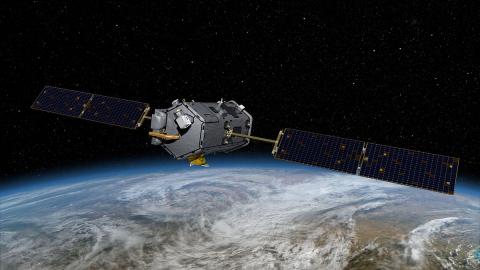Satellite family: OCO (Orbiting Carbon Observatory)
The Orbiting Carbon Observatory (OCO) is a NASA satellite mission intended to provide global space-based observations of atmospheric carbon dioxide (CO2). The first spacecraft was lost in a launch failure on February 24, 2009, when the payload fairing of the Taurus rocket which was carrying it failed to separate during ascent.
NASA successfully launched the second spacecraft on July 2, 2014. Orbiting Carbon Observatory-2 (OCO-2) is NASA’s first dedicated Earth remote sensing satellite to study atmospheric carbon dioxide from space. OCO-2 is an exploratory science mission designed to collect space-based global measurements of atmospheric CO2 with the precision, resolution, and coverage needed to characterize sources and sinks (fluxes) on regional scales (≥1000km). OCO-2 will also be able to quantify CO2 variability over the seasonal cycles year after year. This mission will also validate a space-based measurement approach and analysis concept that could be used for future systematic CO2 monitoring missions.
CO2 is a constituent of the Earth's atmosphere. We know that CO2 is one of several gases that trap heat near the surface of the Earth. These gases are known as greenhouse gases. Many scientists have concluded that substantial increases in the abundance of CO2 will generate an increase in the Earth's surface temperature.
Since the beginning of the industrial age, the concentration of CO2 has increased from about 280 parts per million to about 400 parts per million (ppm) to date. In May 2013, the Mauna Loa Observatory measured a record 400 parts per million in CO2, for the first time ever in human history. Furthermore, a global network of ground-based measurement sites has observed an increase in atmospheric CO2 concentration by almost 20% over the past 50 years - the most dramatic change that we have ever seen in human history. The amount of CO2 added to the atmosphere through human activities, according to the Global Carbon Project (GCP), has been steadily climbing; and the level was over at over 30 billion metric tons in 2005.
The world’s oceans, plants and soils on land, and numerous other less significant carbon pools within the global carbon cycle steadily absorb carbon and are called sinks. They serve to reduce the amount of CO2 that remains in the atmosphere. However, the geographic distributions of carbon uptakes by the oceans and terrestrial ecosystems are still uncertain. In addition, the effectiveness and efficiency of these sinks may change over time as more CO2 is emitted into the atmosphere and, therefore, warrant study.
OCO-2 will be collecting a great number of high-resolution measurements, which will provide a greater spatial distribution of CO2 over the entire globe, in short, a bigger, clearer, more complete picture of global CO2. These measurements will be combined with data from the ground-based network to provide scientists with the information that they need to better understand the processes that regulate atmospheric CO2 and its role in the carbon cycle. This enhanced understanding is essential for improving predictions of future atmospheric CO2 increases and its impact on Earth's climate.
